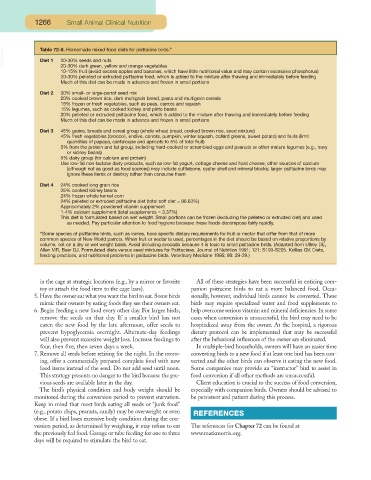Page 1216 - Small Animal Clinical Nutrition 5th Edition
P. 1216
1266 Small Animal Clinical Nutrition
VetBooks.ir Table 72-8. Homemade mixed-food diets for psittacine birds.*
Diet 1
20-30% seeds and nuts
20-30% dark green, yellow and orange vegetables
10-15% fruit (avoid excess apples and bananas, which have little nutritional value and may contain excessive phosphorus)
20-30% pelleted or extruded psittacine food, which is added to the mixture after thawing and immediately before feeding
Much of this diet can be made in advance and frozen in small portions
Diet 2 30% small- or large-parrot seed mix
20% cooked brown rice, dark multigrain bread, pasta and multigrain cereals
15% frozen or fresh vegetables, such as peas, carrots and squash
15% legumes, such as cooked kidney and pinto beans
20% pelleted or extruded psittacine food, which is added to the mixture after thawing and immediately before feeding
Much of this diet can be made in advance and frozen in small portions
Diet 3 45% grains, breads and cereal group (whole wheat bread, cooked brown rice, seed mixture)
45% fresh vegetables (broccoli, endive, carrots, pumpkin, winter squash, collard greens, sweet potato) and fruits (limit
quantities of papaya, cantaloupe and apricots to 5% of total fruit)
5% from the protein and fat group, including hard-cooked or scrambled eggs and peanuts or other mature legumes (e.g., navy
or kidney beans)
5% dairy group (for calcium and protein)
Use low-fat non-lactose dairy products, such as low-fat yogurt, cottage cheese and hard cheese; other sources of calcium
(although not as good as food sources) may include cuttlebone, oyster shell and mineral blocks; larger psittacine birds may
ignore these items or destroy rather than consume them
Diet 4 24% cooked long grain rice
25% cooked kidney beans
24% frozen whole kernel corn
24% pelleted or extruded psittacine diet (total soft diet = 96.63%)
Approximately 2% powdered vitamin supplement
1-4% calcium supplement (total supplements = 3.37%)
This diet is formulated based on wet weight. Small portions can be frozen (excluding the pelleted or extruded diet) and used
as needed. Pay particular attention to food hygiene because these foods decompose fairly rapidly.
*Some species of psittacine birds, such as lorries, have specific dietary requirements for fruit or nectar that differ from that of more
common species of New World parrots. When fruit or nectar is used, percentages in the diet should be based on relative proportions by
volume, not on a dry or wet weight basis. Avoid including avocado because it is toxic to small psittacine birds. (Adapted from Ullrey DE,
Allen MR, Baer DJ. Formulated diets versus seed mixtures for Psittacines. Journal of Nutrition 1991; 121: S193-S205. Kollias GV. Diets,
feeding practices, and nutritional problems in psittacine birds. Veterinary Medicine 1995; 90: 29-39.)
in the cage at strategic locations (e.g., by a mirror or favorite All of these strategies have been successful in enticing com-
toy or attach the food item to the cage bars). panion psittacine birds to eat a more balanced food. Occa-
5. Have the owner eat what you want the bird to eat.Some birds sionally, however, individual birds cannot be converted. These
mimic their owners by eating foods they see their owners eat. birds may require specialized water and food supplements to
6. Begin feeding a new food every other day. For larger birds, help overcome serious vitamin and mineral deficiencies.In some
remove the seeds on that day. If a smaller bird has not cases when conversion is unsuccessful, the bird may need to be
eaten the new food by the late afternoon, offer seeds to hospitalized away from the owner. At the hospital, a rigorous
prevent hypoglycemia overnight. Alternate-day feedings dietary protocol can be implemented that may be successful
will also prevent excessive weight loss. Increase feedings to after the behavioral influences of the owner are eliminated.
four, then five, then seven days a week. In multiple-bird households, owners will have an easier time
7. Remove all seeds before retiring for the night. In the morn- converting birds to a new food if at least one bird has been con-
ing, offer a commercially prepared complete food with new verted and the other birds can observe it eating the new food.
food items instead of the seed. Do not add seed until noon. Some companies may provide an “instructor” bird to assist in
This strategy presents no danger to the bird because the pre- food conversion if all other methods are unsuccessful.
vious seeds are available later in the day. Client education is crucial to the success of food conversion,
The bird’s physical condition and body weight should be especially with companion birds. Owners should be advised to
monitored during the conversion period to prevent starvation. be persistent and patient during this process.
Keep in mind that most birds eating all seeds or “junk food” FERENCES
(e.g., potato chips, peanuts, candy) may be overweight or even REFERENCES
obese. If a bird loses excessive body condition during the con-
version period, as determined by weighing, it may refuse to eat The references for Chapter 72 can be found at
the previously fed food. Gavage or tube feeding for one to three www.markmorris.org.
days will be required to stimulate the bird to eat.

